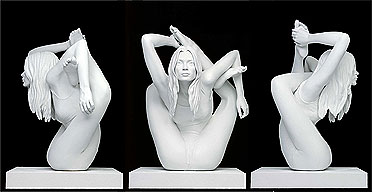Life casting was first documented in in Cennino Cennini's Manuscript "Il Librio del Arté", which was written in 1392. In the book life casting process it attributed to the 'ancients' and no date was made clear. The process of making plaster moulds from the human form are dated back to the 7th/8th millennium BC. It is known that qauze strips were dipped in plaster to cast the remains of the Pharaohs of Egypt in order to give the perfect fit to the sarcophagus that would transport them to the afterlife.
Artists:
.png) Antony Gormley
Antony GormleyGormley is widely acclaimed for his public artwork, installations and sculptures that investigate the relationship of the human body to space. Since the 1960's Gormley's work has developed the potential opened up by sculpture through critical engagement with both his own body and those of others in a way that confronts fundamental questions of where human beings stands in relation to nature and the cosmos. Continually Gormley tries to identify the space of art as a place of becoming in which new behaviors, thoughts and feelings can arise. He describes his work as "an attempt to materialize that place at the other side of appearance where we all live". Lots of his work are molds taken from his own body or "the closest experience of matter that I will ever have and the only part of the material world that I live inside." Gormley's work attempts to treat the body not as an object but a place and in making work that enclose the space of a particular body to identify a condition common to all human beings. I'm not the biggest Gormley fan but I do like some of his sculptures such as GUT VII, SPLEEN II, and BEFORE TWO.

Marc Quinn
Marc Quinn is a leading artist of his generation. His art explores the relationship between art and science, the body perception of beauty and highlighting how the conflict between the 'natural' and cultural' has a grip on the contemporary psyche. In 1999 Quinn came to prominence in 1991 with his sculpture self; a cast of his head made from eight pints of his own frozen blood. Also he is critically acclaimed for Alison Lapper Pregnant (2005) which was exhibited on the fourth plinth at Trafalgar Square in London until 2007. Throughout Quinn's oeuvre he drew on ideas and themes relating to the human body also he had other key subjects that include growth and evolution through topical issues such as genetics and the manipulation of DNA, as well as the issues of life and death and identity. Quinn's uses a range of materials both traditional and untraditional. The materiality of the object, in both it's elemental composition and surface appearance is at the heart of Quinn's work. Why I have looked into Quinn's work as he was one I have previously looked into before. I came across his Sculptures of Kate moss and thought it reminded me of what we where doing in 3D. We casted Amy's and Eleanor's body's whilst they were linked up so they became a 3 legged person. I thought these sculptures looked quite freak show like.
No comments:
Post a Comment